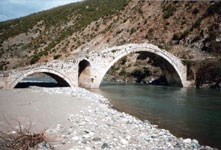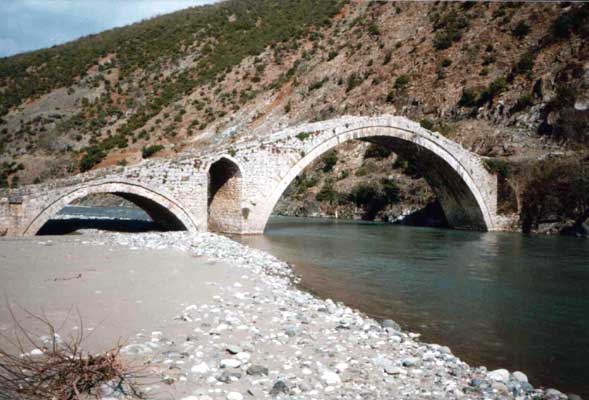| | Robert Elsie | AL Art | AL History | AL Language | AL Literature | AL Photography | Contact | |
Robert Elsie
Texts and Documents of Albanian History
BACK | AL History

Kamara Bridge over the Shkumbin River
at Miraka near Elbasan
(Photo: Robert Elsie).
1308
Anonymous:
Description of Eastern Europe
The so-called 'Anonymi Descriptio Europae Orientalis' (Anonymous Description of Eastern Europe) (1) is a mediaeval Latin text from the year 1308 which contains a survey of the lands of Eastern Europe, in particular the countries of the Balkans. Its anonymous author is thought to have been a French or French-educated cleric, most likely of the Dominican order, who was sent by the church to Serbia where he gained much of his information on the Balkans. The manuscript was edited in Kraków in 1916 by Olgierd Górka. In addition to sections depicting the various regions of Byzantine Greece, Rascia, Bulgaria, Ruthenia, Hungary, Poland and Bohemia, it contains a section on Albania, one of the rare descriptions of the country in the early years of the fourteenth century. We know that the Dominicans were active in Durrës from 1304 onwards when the town fell to the West after twenty years of Byzantine rule. In a letter dated 31 March 1304, Pope Benedict XI had asked the head of the Dominican Order in Hungary to send to Albania some of his subordinates of 'good moral character, active and eloquent' for missionary activities. With the support of the Holy See, the Dominicans thus had full power to set up a Latin hierarchy of their own liking on the Albanian coast to replace the Orthodox church which had been forced to abandon position.
Now we come to speak of Albania, which, on its southern side, is right next to Greece and is situated between Rascia and the land of the Despot (2). Albania is a rather extensive and large region. It has warlike inhabitants indeed, for they make excellent archers and lancers. This whole region is fed by four large rivers: the Ersenta (Erzen), the Mathia (Mat), the Scumpino (Shkumbin) and the Epasa (Osum). The land is productive in meat, cheese and milk; it is not very abundant in bread and wine, though the nobles in particular have enough. They do not have cities, camps, fortifications and farms, but live rather in tents and are constantly on the move from one place to another with the help of their troops and relatives. They do have one city called Duracium (Durrës) which belongs to the Latins and from which they get textiles and other necessities. The Prince of Tarento, son of the King of Sicily (3), now holds sway over part of this kingdom including the city of Durrës. It was the free will of the landowners who, on account of their natural love for the French, spontaneously and freely received him as their lord (4). From Apulia and the city of Brindisi one may cross over to Durrës in one night, and from Durrës one may travel on through Albania to Greece and to Constantinople much more easily and without all the road difficulties and perils of the sea. The Roman emperors of ancient times used this route (5) for it is excessively tedious to transport a large army in such a period of time by sea and by such long roads. The said kingdom of Albania now has no king, the land being divided among the landowners who rule it themselves and who are subject to no one else. This province is called Albania because the inhabitants of this region are born with white (albo) hair. The dogs here are of a huge size (6) and are so wild that they kill like lions. As Pliny mentions, the Albanians sent such a dog to Alexander the Great, which vanquished lions, elephants and bulls in the stadium. They have painted eyes, greyish in the pupils, such that they can see better at night than in the daytime. There are two Albanias, one in Asia near India of which we are not speaking here, and the other in Europe which is part of the Byzantine Empire and of which we are speaking here. It contains two provinces: Clisara (Këlcyra) and Tumurist (7). In addition to these two provinces, it has other provinces next to it: Cumania (8), Stophanatum (9), Polatum (Pult) and Debre (Dibra) which are provinces tributary to the Albanians and more or less subjected to them, for they are active in farming, tend their vineyards and take care of the necessities of life at home. The inhabitants of these provinces do not move from place to place as the aformentioned Albanians do, but live rather in solid mansions and towns, nor are they entirely Catholic or entirely schismatic. Should anyone preach the word of God to them, they would pretend to be true Catholics for it is reported that by nature they have a liking for the Latins. The aforementioned Albanians have a language which is distinct from that of the Latins, Greeks and Slavs such that in no way can they communicate with other peoples. This is enough on Albania.
(1) cf. Elsie, Albania in the 'Anonymi Descriptio...', 1990. (2) i.e. the Despot of Epirus. (3) Philip, Prince of Taranto. (4) cf. Du Cange, Hist. Const. I. 102. (5) Reference here is to the Via Egnatia, the main road of ancient communication between Rome and Constantinople, passing through Durrës, Elbasan and Ohrid. (6) Half a millennium later, the English painter and poet Edward Lear (1812-1888) was to make the same discovery on his travels down the Himaran coast in 1848. In his 'Journal of a landscape painter in Greece and Albania' (London 1851), he records on 22 October 1848 being attacked by "some thirty immense dogs, who bounced out from the most secluded corners and would straightway have breakfasted on me had I not been so aptly rescued; certainly the dogs of Khimára are the most formidable brutes I have yet seen." (7) Probably in the Myzeqe region around Kavaja. The chronicle of John Musachi speaks of a locality called Tomorista. (8) No doubt Chounavia, formerly the site of an Orthodox diocese, somewhere between Durrës and the Mat region, perhaps on the Ishëm river. (9) No doubt Stephanatum, a diocese of the time somewhere near Durrës. [Extract from: Olgierd Górka (ed.): Anonymi descriptio Europae orientalis. Imperium Constantinopolitanum, Albania, Serbia, Bulgaria, Ruthenia, Ungaria, Polonia, Bohemia. Anno MCCCVIII exarata, Kraków 1916, p. 25 29. Translated from the Latin by Robert Elsie. First published in R. Elsie: Early Albania, a Reader of Historical Texts, 11th - 17th Centuries, Wiesbaden 2003, p. 23-25.]
TOP
